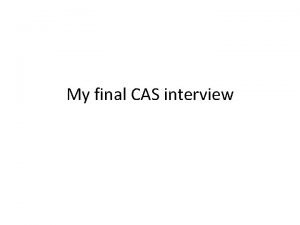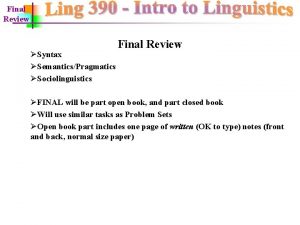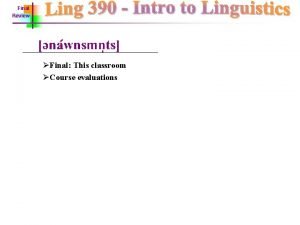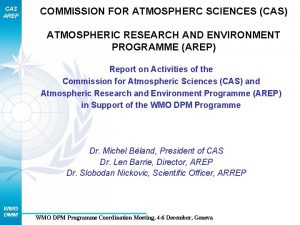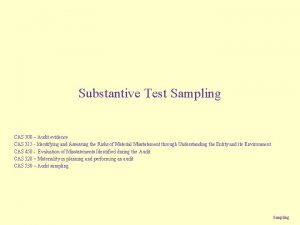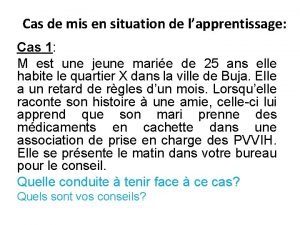CAS 3 SH 3 Final Review The Final


















- Slides: 18

CAS 3 SH 3 Final Review

The Final Tue 28 th, 7 pm, IWC 3 closed book, closed note Non-comprehensive: memory management, storage & file system Types of questions: multiple choice, long answers You can bring Mc. Master standard calculator; no Internet-enabled devices • All-in-one slides on course page • Office hrs: (April 6 – 10 th, 20 th – 24 th) • • • – – Tue. 4 – 6 pm, Wed. 10 – 3 pm; By appt other time Please resolve all grading related issues by April 24 th >= 85 -- A; > 90 – A+ Note: out of town April 13 th – 17 th

Materials covered since midterm • Memory management • Storage and file systems Two key aspects • Data structure – What – Where: in memory/cache/register, on disk • Algorithms

Memory Management • • Understand the distinctions between virtual (logical) address space and physical address space Understand different approaches to memory management: contiguous vs. noncontiguous, fixed vs variable size partitions, segmentation, paging. Pros and cons of each approach What are external fragmentation and internal fragmentation? Segmentation: segmentation table, how to translate from virtual address to physical address? when errors occur? Virtual Address Seg # offset Offset Base 0 Base 1 Base 2 Base 3 Base 4 Base 5 Base 6 Base 7 Limit 0 Limit 1 Limit 2 Limit 3 Limit 4 Limit 5 Limit 6 Limit 7 V V V N N V > Error + Physical Address Check Valid Access Error

Memory Management • Paging: page table, page table entry, how to translate from virtual address to physical address? when errors occur? • Special bits in PTE • Impacts of page size Virtual Address: Page # Offset Page. Table. Ptr Page. Table. Size > Access Error page #0 page #1 page #2 page #3 page #4 page #5 V, R, W N V, R, W Physical Page # Offset Physical Address Check Perm Access Error

Paging (cont’d) • TLB, multilevel paging, inverted page table, combing paging with segmentation – Pros and cons • Compute the size of page table(s) and the maximum size of logical address space of 32 -bit and 64 -bit systems Advantages Disadvantages Segmentation Fast context switching: Segment mapping maintained by CPU External fragmentation Paging (singlelevel page) No external fragmentation, fast easy allocation Large table size ~ virtual memory Paged segmentation Table size ~ # of pages Multiple memory references in virtual memory, fast per page access easy allocation Two-level pages Inverted page table Table size ~ # of pages Lookup time in physical memory If combined with hash table, two memory lookups

Virtual memory • • Swap file/partition on disk (in raw, no file system) Understand the needs for on-demand paging Valid bit in PTE to indicate whether a page in memory Page faults – Type of pages faults: compulsory misses, policy misses, capacity misses – Cost of page faults – Steps in handling page faults • Understanding the notions of temporal and spatial locality, and their implication on page replacement policies and working sets • Page replacement policies (FCFS, OPT, LRU, 2 nd chance, clock algorithm) – Given a reference sequence, can determine the # of page faults – Belady’s anomaly • Working sets: the definition, how to compute working sets, how to avoid thrashing

Types of page faults & remedies Bag of tricks • Prefetching • Tracking workset • Swapping processes • Page replacement algorithms • Copy-on-write • Capacity misses • Compulsory misses • Policy misses

Storage and File Systems • Organization of magnetic disks • Average access time of magnetic disk • Disk addressing: organize sectors into blocks and use logical block address (LBA) • Disk scheduling: – Goal: minimizing seek time – Policies: FIFO, SSTF, SCAN, C-LOOK • Disk management [file systems]: – Formatting in two steps: 1) partitioning 2) making file system (not applicable for raw disk partitioning) – Boot sequence: BIOS, master boot record (locate boot partition), volume boot record (loading OS) • Swap space [memory management]

Storage • Understand MTF, MTR and MTDL – Able to determine MTF, MTDL for simple schemes such as mirroring • Redundant array of inexpensive (independent) disks (RAID) – Mirroring, stripling, parity, (7, 4) hamming code – Error detection vs error correction; bit level vs. block level stripling – Different RAID configuration

File systems • Directory – what is stored in directory: (file name, FCB block) organized as a linear array or hash table – How are directories organized: tree, acyclic graphs – How to locate a file “/home/me/file 1”? (starting from the root directory, find the FCB corresponding to the subdirectories and finally the file) – Recently accessed directories cached in memory • Files: abstract data type, contiguous logical space (to users) – File operations: read, write, open, close, … – FCB – Disk allocation and translation: contiguous allocation, linked allocation, index allocation – The maximum size of file is determined by the allocation schemes

File systems • In memory and on-disk data structure – What happens when creating, opening, reading a file? In memory on-disk Mount table Directory cache system-wide open-file table per-process open file table (PCB) Buffers for file system blocks MBR Boot control block Volume control block Directory structures FCB and data blocks of each files

Discussion • In paging, the physical address can be computed by adding the physical page # and the offset (false) – Adding appending • Consider the use of multilevel paging. Suppose a page table in each level can be no larger than 4096 Byte, and the size of each entry in the page table is 4 Byte. With 32 -bit logical address space, a) what is the minimum # of levels needed if the page size is 4096 Byte, and b) how many physical memory references are needed for each logical memory reference if no TLB is used. – (a) 232/212 = 220 2 levels – (b) # of memory reference = # of levels + 1 • The following bits are typically kept in a page table entry: valid bit, read-only bit, use bit, reference bit, and dirty bit. – use bit is the same as reference bit

Discussions • Consider the following memory references 2 1 4 2 5 2 1 6 5. Suppose only 3 physical frames in the memory. The number of page faults generated by FIFO (including compulsory PFs) is, ______The number of page faults generated by OPT is, ______The number of page faults generated by LRU is, ______The number of page faults generated by the clock algorithm is, ______ 2 FIFO 2 OPT 2 2 5 5 5 6 6 1 1 1 2 2 2 5 4 4 4 1 1 1 2 2 2 6 1 1 4 5 5

2 1 4 2 5 2 1 6 5 2 LRU Clock 2 u: 0 2 2 2 5 1 1 5 5 6 6 4 4 1 1 1 2 u: 0 2 u: 1 1 u: 0 4 u: 0 2 u: 1 1 u: 0 4 u: 0 2 u: 0 6 u: 0 5 u: 0 1 u: 0 6 u: 0 5 u: 0 2 u: 1 5 u: 0 4 u: 0

C-SCAN

C-LOOK

Good luck • Please remember to fill in teaching evaluation!
 Ap gov final review
Ap gov final review Final cas interview
Final cas interview Hát kết hợp bộ gõ cơ thể
Hát kết hợp bộ gõ cơ thể Bổ thể
Bổ thể Tỉ lệ cơ thể trẻ em
Tỉ lệ cơ thể trẻ em Chó sói
Chó sói Chụp phim tư thế worms-breton
Chụp phim tư thế worms-breton Hát lên người ơi
Hát lên người ơi Các môn thể thao bắt đầu bằng tiếng nhảy
Các môn thể thao bắt đầu bằng tiếng nhảy Thế nào là hệ số cao nhất
Thế nào là hệ số cao nhất Các châu lục và đại dương trên thế giới
Các châu lục và đại dương trên thế giới Công thức tính thế năng
Công thức tính thế năng Trời xanh đây là của chúng ta thể thơ
Trời xanh đây là của chúng ta thể thơ Mật thư tọa độ 5x5
Mật thư tọa độ 5x5 101012 bằng
101012 bằng Phản ứng thế ankan
Phản ứng thế ankan Các châu lục và đại dương trên thế giới
Các châu lục và đại dương trên thế giới Thể thơ truyền thống
Thể thơ truyền thống

